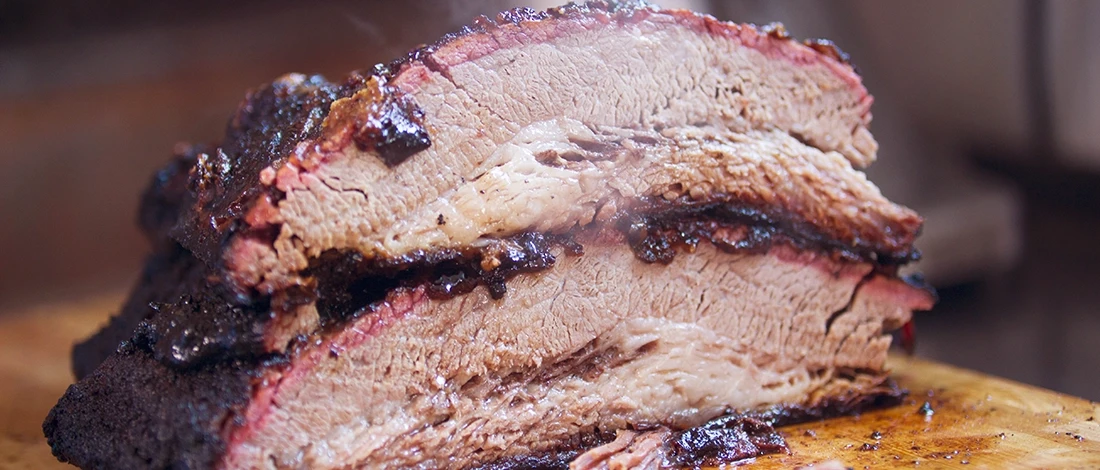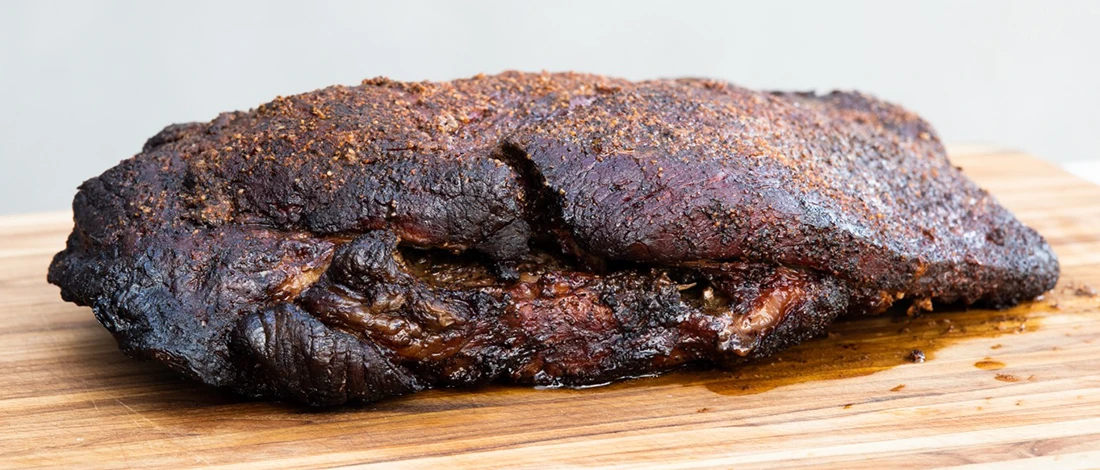Brisket is traditionally seen as a relatively inexpensive cut of meat and one that is less desirable due to the potential toughness inherent in the cut.
You may have noticed that the price of brisket has increased dramatically, and it can no longer be considered economical! Our market research has revealed the main reasons for the increase in brisket prices.
Quick Summary
- Brisket prices have risen due to limited supply, with only two briskets per cow, and not all are suitable for smoking or BBQ.
- The demand for brisket has increased across various sectors, including backyard smoking, fast-food, upmarket restaurants, and cultural dishes.
- The price of beef has increased overall due to environmental conditions and increased production costs, affecting brisket prices.
- For those without immediate access to local sources, services like ButcherBox can be a convenient alternative.
From being considered a poor man's cut of meat, the brisket has been elevated to almost celebrity-like status in the meat smoking and BBQ world.
The sudden rise to fame, combined with restricted supply, has further limited the availability! Let's take a look at how the price of brisket made this leap in our modern culture!
How Much Does Brisket Cost?

Brisket has seen a significant increase in price over the years.
The increase is such that it can no longer be considered a cheap cut of meat.
The price of brisket will vary depending on the quality of the meat, but you can brace yourself to pay anywhere from $8 to $10 per pound.
Prime grade brisket can cost even more than this due to the higher quality of the meat and the more extensive marbling [1].
Prime grade brisket can cost even more than this due to the higher quality of the meat and the more extensive marbling [1].
The price of brisket has seen an increase in price from between 30% to 40% in a relatively short time.
It can be anywhere from $30 per pound upwards in a restaurant. Why is brisket so expensive, then?
Why Has The Price For Brisket Increased?

As with most commodities, the price of brisket is related to supply and demand, but many factors influence the available supply and the market demand for the cut.
We will examine some of the main issues that have resulted in a dramatic increase in brisket prices [2].
1. Brisket Has A Limited Supply
One of the most significant contributing aspects to the increase in price for briskets is that there are only two briskets per cow.
Another contributing factor is that the brisket from every cow is different. Some are not suitable for the restaurant or smoking industry because they are not meaty enough or as well developed.
When most customers are buying brisket products, they get the entire product. Consequently, one cow can supply only two briskets per customer.
In days gone by when brisket was not a popular meat cut, butchers would cut the brisket up into smaller portions, which would allow more customers to be supplied with the meat.
The way the market uses brisket has seen a shift in the way customers purchase the cut, which is now usually the entire brisket.
2. The Price For Beef Has Increased Across The Board

Brisket is not the only cut of beef that has seen a price increase.
Beef, in general, has seen an increase in prices to the consumer for several reasons. Your favorite skirt steak, ground beef, and corned beef are also more expensive.
Current environmental conditions, such as drought and viral lockdowns, have impacted cattle farming significantly [3].
Many of the main cattle farming regions have experienced severe drought, which has resulted in a reduction of herd sizes and consequently restricted the supply of beef.
Cattle farmers' production costs have also increased, including fuel prices, making it more expensive to raise the cattle to slaughter age.
The increased costs to raise the cattle, such as land prices, are an expense that is passed on to the consumer.
3. Increase In Demand For Brisket

Increased Interest In Backyard Smoking
There has been an upsurge in the popularity of backyard meat smoking over recent years due to family gatherings.
The production of easy-to-use smokers and simple methods to monitor the temperature of the meat has made this process accessible to more people.
Consequently, there has been a recent significant increase in people actively participating in smoking meat at home.
Since a well-smoked brisket is considered the pinnacle of meat smoking prowess, the popularity of brisket in the meat smoking community has increased dramatically.
Fast-Food Market Demand For Brisket
Brisket has other demands in the market besides BBQ or smoking purposes. Historically brisket is the preferred cut for producing hamburger meat.
The proliferation of fast-food vendors has increased the demand for quality hamburger meat. This situation has placed additional strain on the meat suppliers and cattle ranchers, resulting in low supply.
Considering there are only two briskets on each cow, you can quickly see how the fast-food market can impact the demand for this meat and push the price of brisket to new heights.
Demand For Brisket By Upmarket Restaurants

The increase in the popularity of brisket in the general population has seen brisket being included on the menu of upmarket restaurants and barbecue joints.
Previously, these restaurants would not have considered including brisket as an offering for their clientele because it was seen as a cheap cut of meat. Brisket also takes a long time to cook or smoke to a tender, juicy meal.
The increase in demand for BBQ or smoked brisket among patrons has seen upmarket restaurants and BBQ restaurant establishments including these meals on their menu and charging high prices.
This has increased the demand pressure on beef suppliers and cattle ranchers for quality brisket.
Cultural Dishes Using Brisket
Many cultures use brisket as a traditional dish, which stems from when brisket was a cheap, affordable cut of meat.
These affordable meals using brisket have become integral parts of the culture of the communities where this meal became a staple offering.
The Jewish immigrant community is one such cultural group where brisket has become integral to their traditions.
The BBQ States Impact On Brisket Demand
In some US states, BBQ and smoking meat is seen as a national pastime and has become integral in the culture of the populations of these regions.
States such as Texas and Missouri have BBQ and smoking competitions and festivals, attesting to the popularity of outdoor cooking in these populations.
Brisket is a popular cut of meat to use in both grilling and smoking in these states. The demand contributes to the overall shortage of brisket and the increasing demand from other market sectors.
Competition For Brisket Supply

With the high demand for brisket and some big-money consumers who have the buying power to buy in bulk, not much of the supply is left available for the average consumer.
As a result, brisket is becoming increasingly rare for individual consumers at the supermarket shelf or the local butcher.
So not only is the quality brisket becoming difficult to find in the shops when you do find it, you are expected to pay a premium price.
Other Meat-Related Articles: Is Corned Beef Healthy?
Texas Style Smoked Beef Brisket

- Prep Time: 30 minutes
- Cook Time: 15 hours, plus 1 hour of resting time
- Total Time: 16 hours and 30 minutes
- Number of Servings: 14
Ingredients
- 14-pound packer brisket
- 2 tablespoons kosher salt
- 2 tablespoons black pepper
- 1 tablespoon garlic
- 1 tablespoon onion
- 1 teaspoon chili (optional)
Instructions
- Preheat your smoker to 225 degrees.
- Trim the cold brisket, removing silver skin, excess fat, and squaring edges.
- Mix all rub ingredients, adding cayenne for heat, and coat the brisket thoroughly.
- Smoke with the point end towards the heat source until it reaches 165 degrees, then wrap tightly in butcher paper and continue smoking until 205 degrees.
- Let rest for an hour before slicing against the grain and serving with traditional sides like white bread, cheddar, and pickles.
References:
- http://www.clarionfarms.com/cuts-and-pricing
- https://www.wsj.com/articles/brisket-was-cheap-and-delicious-now-its-expensive-and-you-have-to-wait-in-line-1423180291
- https://www.cnbc.com/2021/11/18/why-have-beef-prices-gone-up.html








